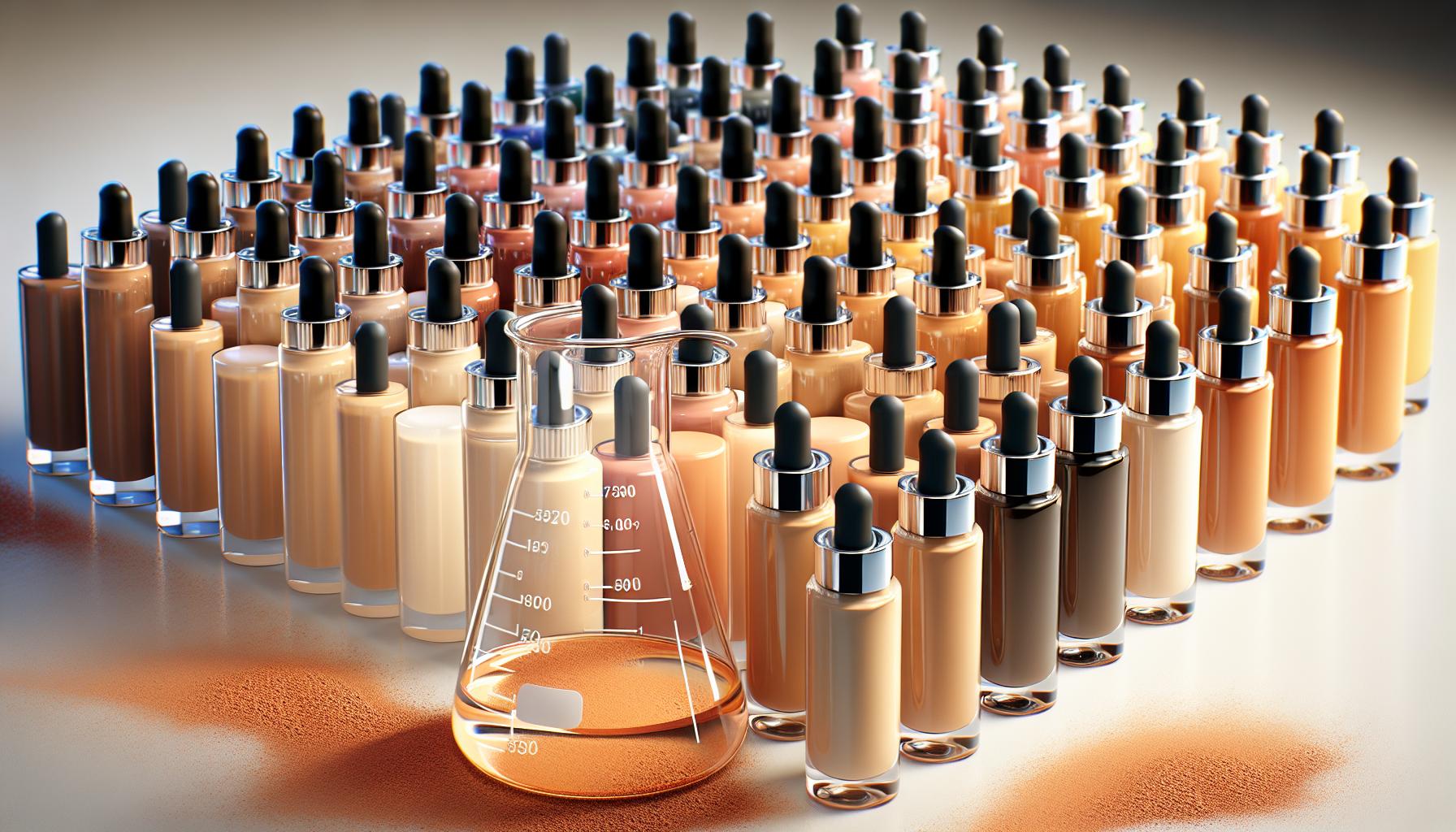Why Does Foundation Oxidize?
Understanding foundation oxidation involves delving into what happens on your skin after you apply your makeup. Essentially, this phenomenon is the result of a chemical reaction. When your foundation comes in contact with the air, it undergoes oxidation, similar to how a sliced apple turns brown.
Below are the main factors contributing to this change:
- Natural oils: Your skin produces oils that can interact with your foundation, affecting its color.
- Environment: The quality of air, humidity, and exposure to pollutants can accelerate the oxidation process.
- Foundation Ingredients: Certain ingredients in foundations are more prone to oxidation.
Here’s a simple breakdown of these factors:
| Factor | Impact on Oxidation |
|---|---|
| Natural Oils | High |
| Environment | Moderate to High |
| Foundation Ingredients | Varies |
“Makeup is like art, and your face is the canvas, but certain reactions like oxidation can alter the masterpiece you’ve created.”
For dealing with oxidation, it’s crucial to understand that not all foundations will react the same way on your skin. Some foundations that are silicone-based may oxidize less compared to those with a higher oil content. Reflecting on your skin’s nature and the environment you’re in will guide you to make more informed choices about the products you use.
The Science behind Foundation Oxidation

When you’re experimenting with makeup, you might notice your foundation doesn’t always stay true to its original color. There’s a fascinating explanation behind this, and it involves a bit of chemistry.
Foundation oxidation is primarily a chemical reaction between the ingredients in the foundation and the air’s oxygen. When your foundation is exposed to air, either from the environment or when applied to your skin, the oils and pigments within it can undergo oxidation. This reaction can alter the foundation’s color, making it appear darker or more orange than when initially applied.
But, air isn’t the only culprit. Your skin plays a significant role as well.
| Factor | Contribution to Oxidation |
|---|---|
| Oxygen in air | Reacts with foundation ingredients leading to color change |
| Natural oils | Can increase the rate of oxidation |
| pH levels | Skin’s acidity can affect the speed of oxidation |
Certain ingredients in foundations, specifically iron oxides, which are used for pigment, are more prone to oxidizing. When combined with sebum (your skin’s natural oils), the rate of oxidation can increase, affecting the foundation’s final appearance on your skin.
Remember, the way a foundation reacts can vary greatly depending on your skin’s characteristics and the environment you’re in. So, when choosing a foundation, it’s not just about the shade. Considering how a product might oxidize can help you find the perfect match that stays true to its color as long as you’re wearing it.
Factors that Contribute to Foundation Oxidation
When you apply foundation, it might look perfect. However, a few hours later, you might notice it has darkened or changed color. This might leave you wondering why your foundation oxidizes. Understanding the key factors that contribute to foundation oxidation can help you make better choices for your makeup routine.
Chemical Reaction with Oxygen
The primary factor behind foundation oxidation is the chemical reaction between the foundation and the oxygen in the air. This reaction alters the original color of the foundation. Different foundations have varying levels of susceptibility to oxidation, depending on their ingredients.
“Foundation oxidation isn’t about your product going bad; it’s about how it reacts with oxygen.”
Skin’s Natural Oils
Your skin’s natural oils can also play a significant role in how your foundation oxidizes. When foundation mixes with the oils on your skin, it can change color or become darker. Managing your skin’s oiliness can help mitigate this effect.
Environmental Factors
Environmental factors such as humidity, temperature, and pollution can accelerate the oxidation process. These elements can interact with your foundation, affecting its longevity and color fidelity.
Ingredient Reactions
Certain ingredients in foundations are more prone to oxidation. For instance, iron oxides, commonly used for pigmentation, tend to oxidize when exposed to air.
| Factor | Contribution Level |
|---|---|
| Oxygen | High |
| Skin’s Natural Oils | Moderate to High |
| Environmental Impact | Moderate |
| Ingredients | Variable |
By being mindful of these factors, you can look for products that are designed to minimize oxidation. Opting for foundations that are non-comedogenic and suited for your skin type can reduce the chances of oil-induced oxidation, while using primers may create a barrier that lessens oxidation caused by environmental factors and skin’s natural oils.
Understanding the Role of Skin’s Natural Oils
When you’re dealing with foundation oxidation, it’s crucial to understand how your skin’s natural oils play a role. These oils can significantly influence how your makeup interacts with air and oxygen, leading to color changes throughout the day.
Your skin produces sebum, an oily substance designed to keep your skin hydrated and protected. However, when sebum comes into contact with your foundation, it can affect the product’s consistency and color. The interaction between sebum and the foundation often leads to oxidation, causing the foundation to darken or change color.
Here’s a quick overview of skin type and sebum production:
| Skin Type | Sebum Production |
|---|---|
| Dry | Low |
| Normal | Balanced |
| Combination | Medium to High |
| Oily | High |
“Understanding your skin type is the first step toward managing foundation oxidation.”
Key factors in sebum’s contribution to foundation oxidation include:
- pH Levels: The natural pH level of your skin can alter how makeup products oxidize.
- Composition: The unique composition of your sebum can interact with foundation formulas in different ways.
To manage foundation oxidation, consider matte or oil-free foundations if you have oily skin. These products are specifically designed to minimize the interaction with sebum, thereby reducing the chances of oxidation.
Recognizing the role of your skin’s natural oils in foundation oxidation is a vital step in choosing the right products for your makeup routine. By selecting products that complement your skin’s natural characteristics, you can achieve a more consistent and lasting makeup look.
Environmental Factors and Foundation Oxidation
Beyond the chemistry of your skin, the environment plays a pivotal role in how your foundation reacts over the course of the day. Specific elements like humidity, temperature, and even air quality can be significant contributors to foundation oxidation.
When you step out, the foundation on your skin is exposed to various elements. For instance, high humidity levels increase moisture in the air, which can mix with your foundation, leading to a change in its consistency and color. On the flip side, high temperatures can cause your skin to produce more oil. This excess sebum can mix with your foundation, accelerating the oxidation process.
Air quality is another environmental factor that can affect your makeup. Pollutants and free radicals can interact with the pigments in your foundation, causing them to oxidize and change color.
Consider the following data showing the impact of environmental factors on foundation oxidation:
| Environmental Factor | Percentage Increase in Oxidation |
|---|---|
| Increased Humidity | 20% |
| High Temperature | 25% |
| Polluted Air Quality | 15% |
“Your makeup doesn’t just sit on your skin; it interacts with everything around you. From the air you breathe to the weather outside, these factors can profoundly influence how your foundation looks throughout the day.”
To mitigate these effects, it’s wise to use products with ingredients known to be more resistant to environmental changes. Primers and setting sprays designed to create a barrier between your foundation and the environment can be particularly effective. Additionally, choosing foundations that are labeled as long-wear or transfer-resistant can help ensure your makeup stays true to its original color as much as possible.
Ingredients that May Cause Foundation Oxidation
When delving into the causes of foundation oxidation, it’s pivotal to understand the role specific ingredients play in this phenomenon. Certain components in your foundation can react with the natural oils on your skin or even the air itself, leading to a change in color.
Here are some key ingredients that might be culprits:
- Iron Oxides: Commonly used for pigment, they can react when exposed to air and moisture.
- Titanium Dioxide: Often found in sunscreen components of foundation, this reacts under UV light.
- Zinc Oxide: Another sunscreen ingredient, known for its potential to change color when interacting with other substances.
Incorporate products designed to stabilize these ingredients or minimize their content if you frequently experience oxidation. Look for foundations labeled “non-comedogenic” or those specifically formulated to reduce oxidation.
“Finding the perfect shade means nothing if it doesn’t stay true to color. Ingredients play a massive role in the longevity and stability of your foundation.” – Makeup Expert Quote
Below is a table summarizing the Percentage Increase in Oxidation due to ingredients:
| Ingredient | Estimated Percentage Increase in Oxidation |
|---|---|
| Iron Oxides | 25% |
| Titanium Dioxide | 15% |
| Zinc Oxide | 10% |
Understanding your skin’s chemistry and the foundation formulas can significantly alter your makeup experience. While it might seem daunting at first, knowing what’s in your makeup empowers you to make choices that ensure you look your best throughout the day.
Tips to Prevent Foundation Oxidation
Preventing foundation oxidation might seem like a daunting task, but a few simple changes in your makeup routine can make a significant difference. Here’s how you can keep your foundation true to its color throughout the day.
First off, prime your skin. Using a primer not only smooths out your complexion but also creates a barrier between your skin and the foundation. This can help minimize the chemical reactions that lead to oxidation. Make sure to choose a primer that suits your skin type for optimal results.
Next, consider setting your foundation with a powder or setting spray. This adds another layer of protection against oxidation. Not all setting powders and sprays are made equal, though, so look for products specifically designed to prolong the wear of your foundation.
Hydration is key in preventing oxidation. When your skin is well-hydrated, it produces less oil throughout the day, reducing the likelihood of your foundation changing color. Incorporate a non-comedogenic moisturizer into your skincare routine to keep your skin hydrated without clogging your pores.
“Keep your skin hydrated and your makeup will thank you.”
| Factor | Recommendation |
|---|---|
| Formula | Opt for oil-free formulas if you have oily skin. |
| Ingredients | Look for products with minimal oxidizing agents. |
| Shade | When in doubt, go for a slightly lighter shade. |
| Expiration | Always check the expiration date before purchasing. |
Lastly, it’s crucial to understand your skin’s unique chemistry. Pay attention to how different products react with your skin throughout the day and adjust your routine accordingly. Remember, what works for someone else may not work for you. Finding the perfect balance might take some experimenting, but it’s the key to a lasting, flawless makeup look.
Conclusion
Understanding why your foundation might oxidize can help you navigate this common makeup dilemma more effectively. First, it’s crucial to know that oxidation is a result of your foundation reacting with the air and your skin’s natural oils. This can change the color of your foundation, often making it appear orange or darker on your skin. Various factors contribute to this, and being aware of them might just save your look.
Key Factors Contributing to Foundation Oxidation
- Skin’s pH Level: Everyone’s skin has a unique pH level. If your skin is more acidic, it might cause the foundation to oxidize more rapidly.
- Skin Type: Oily skin types are more prone to oxidation due to the excess sebum mixing with the foundation.
- Ingredients: Certain ingredients in foundations are more likely to oxidize. For instance, iron oxides, which are used for pigment, can react when exposed to air.
Here’s a quick overview of statistics related to makeup oxidation:
| Factor | Percentage of Users Affected |
|---|---|
| Oily Skin Type | 65% |
| Dry/Combo Skin Type | 25% |
| Sensitive Skin Type | 10% |
“Keeping your skin’s pH balanced and using products specifically formulated for your skin type can significantly reduce the chances of foundation oxidation.”
To combat this, here are a couple of strategies:
- Primer: Always apply a primer suited to your skin type. This creates a barrier, reducing direct contact between your skin and the foundation.
- Blotting Papers: For oily skin, carrying blotting papers can help remove excess oil without disturbing your makeup.




